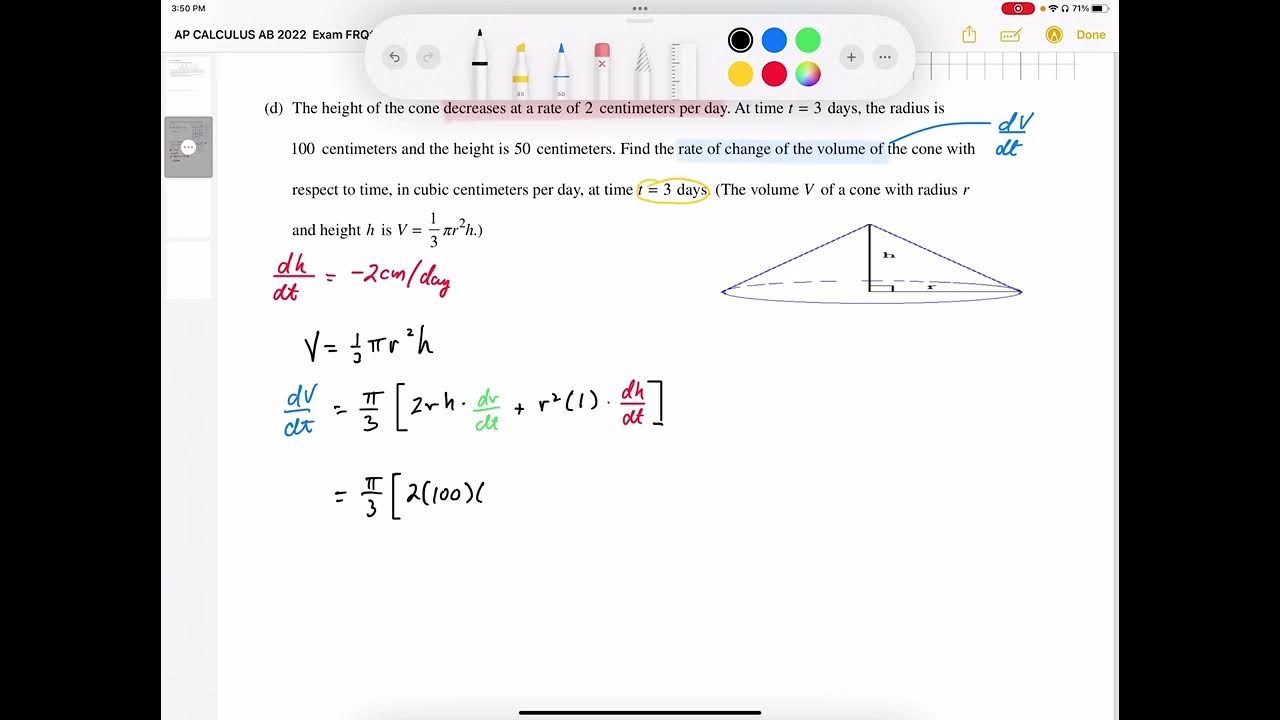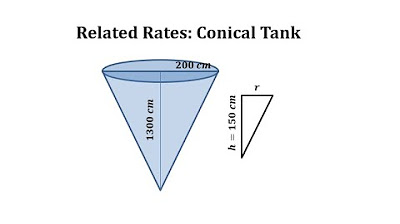Calculus gr 12 Exam Questions
TLDRThe video discusses a problem involving a cylindrical cone water tank where the ratio of height to radius is given. The main objective is to determine the rate at which the volume of water in the tank changes as water is pumped in at a constant rate, specifically when the water depth is 5 cm. The solution involves deriving the formula for the tank's volume, substituting the height-radius ratio, and then differentiating to find the rate of change. The final result reveals the rate of volume change with respect to height.
Takeaways
- 🔍 The problem involves a cylindrical cone-shaped water tank, with a height (H) and radius (r).
- 📏 The ratio of the height to the radius of the tank is 5:2, meaning H/r = 5/2.
- 💧 Water is being pumped into the tank at a constant rate, and the task is to determine the rate at a specific depth.
- 🧮 The question involves calculating the rate of change of the volume of water in the tank when the height is 5.
- ✍️ To solve this, the first derivative of the volume with respect to height (dV/dH) needs to be found.
- 🔗 The relationship between height and radius is used to express r in terms of H, and then substitute into the volume formula.
- 📉 The volume formula for a cone is V = 1/3 * π * r^2 * H.
- 📊 After substitution and simplification, the volume is expressed in terms of H alone, which allows taking the derivative.
- ➗ The first derivative is then calculated, and the given height value is substituted to find the rate at that specific depth.
- 📏 The final answer reflects the rate of change of the volume with respect to the height at H = 5, given as 12.57 cubic centimeters per centimeter.
Q & A
What is the main focus of the problem discussed in the transcript?
-The main focus of the problem is determining the rate of change of the volume of water flowing into a cylindrical cone-shaped tank when the depth (height) of the water is 5 units.
What is the significance of the ratio of height to radius being 5 to 2 in the problem?
-The ratio of height to radius being 5 to 2 allows the speaker to express the radius in terms of the height, which is crucial for simplifying the volume formula and taking the derivative.
Why is it necessary to express the radius in terms of height before taking the derivative?
-It's necessary to express the radius in terms of height to ensure that the volume formula only contains one variable, making it possible to take the derivative with respect to height.
How does the speaker simplify the volume formula after substituting the radius in terms of height?
-The speaker substitutes the radius (R = 0.4H) into the volume formula, simplifies it, and ends up with the expression V = (4/75)πH³ for the volume of the water in the tank.
What is the significance of taking the first derivative in this problem?
-Taking the first derivative of the volume with respect to height gives the rate of change of the volume, which is the quantity being sought in the problem.
What value does the speaker calculate after taking the derivative and substituting the height of 5 units?
-The speaker calculates the rate of change of the volume to be 12.57 cubic centimeters per centimeter of height when the height is 5 units.
Why does the speaker mention that the units will not cancel out?
-The speaker mentions that the units (cm³ per cm) do not cancel out to highlight that the rate of change is expressed in terms of volume per unit height, which is a valid and meaningful result in the context of the problem.
What is the difference between this problem and a typical optimization problem?
-In a typical optimization problem, the goal would be to find the height that maximizes or minimizes the volume. In this problem, however, the task is to determine the rate of change of the volume at a specific height.
Why does the speaker mention the derivative notation (dV/dH)?
-The speaker mentions the derivative notation (dV/dH) to clarify that they are finding the rate of change of volume with respect to height, which is the derivative of the volume function.
What does the final answer of 12.57 represent in the context of the problem?
-The final answer of 12.57 represents the rate at which the volume of water in the tank is increasing when the water's depth is 5 centimeters. It is expressed in cubic centimeters per centimeter.
Outlines
📈 Understanding the Rate Problem in Optimization
This paragraph introduces a problem involving a cylindrical cone water tank, where the goal is to determine the rate at which the volume changes as water is pumped into the tank. The ratio of the tank’s height to its radius is provided, which helps in expressing the radius in terms of height. The problem emphasizes understanding how the rate (or gradient) is determined, particularly when the height is given as five units. The paragraph clarifies that this is not a typical optimization problem but focuses on finding the rate of change of volume.
🔍 Calculating the Rate of Change at a Specific Height
This paragraph details the process of substituting the height into the derived formula to calculate the rate of change of volume. By plugging in the height value of five, the first derivative is computed, giving the rate of volume change as 12.57 cm³ per cm of height. The paragraph explains the units involved and reassures the reader that understanding the units is not crucial for obtaining the correct answer. The focus is on accurately determining the final rate of change as per the problem's requirements.
Mindmap
Keywords
💡Optimization
💡Rate
💡First Derivative
💡Cylindrical Cone
💡Volume
💡Height-to-Radius Ratio
💡Pi (π)
💡Gradient
💡Variable Elimination
💡Centimeter Cubed per Centimeter
Highlights
The problem appears to be an optimization question but is actually about determining the rate at which water flows into a tank.
The water tank is in the shape of a cylindrical cone, with the ratio of height to radius given as 5 to 2.
Mathematically, the ratio can be expressed as H/R = 5/2.
The problem requires determining the rate of change of the water volume when the water depth is 5.
This rate is equivalent to the gradient or first derivative of the volume with respect to the height.
The formula for the volume of a cylindrical cone is provided: V = (1/3)πr²h.
Since the problem involves only one variable, the radius (R) is eliminated using the ratio: R = (2/5)H.
Substituting R = (2/5)H into the volume formula results in V = (4/75)πH³.
The first derivative of the volume with respect to height is then calculated as dV/dH = (12/75)πH².
To find the rate when the height is 5, substitute H = 5 into the derivative.
The calculated rate (first derivative) when H = 5 is 12.57 cm³ per cm of height.
The units of the rate are in cm³ per cm, reflecting how the volume changes with respect to height.
The problem is not an optimization question, so the derivative is not set to zero.
The final answer is the rate of volume change at a specific height, not the maximum or minimum volume.
Understanding the units (cm³ per cm) can be complex, but the focus should be on calculating the rate correctly.
Transcripts
Browse More Related Video

Related Rates - Filling a Cone Problem

AP CALCULUS AB 2022 Exam Full Solution FRQ#4d

2019 AP Calculus AB & BC Free Response #4

Related Rates Applicate: Leaking Conical Tank

Related rates: water pouring into a cone | AP Calculus AB | Khan Academy

Learn how to solve a related rate of loosing water from a cone
5.0 / 5 (0 votes)
Thanks for rating: